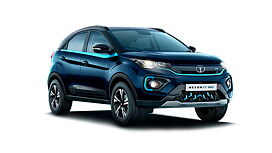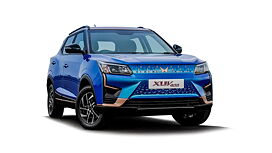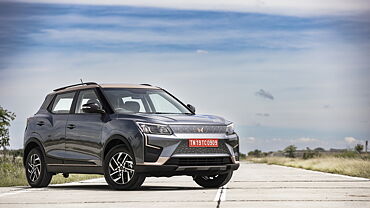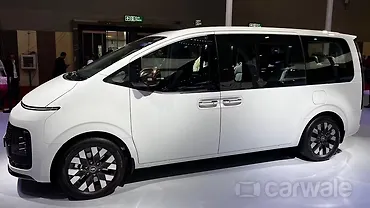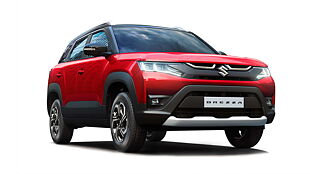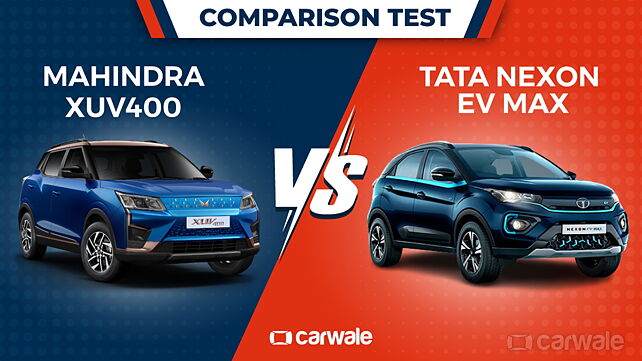
Introduction
Mahindra has entered the private market electric game (once again)with the XUV400. Based on the XUV300, it’s a direct rival to the Tata Nexon EV Max and will be launched in India in January 2023. How does it stack up to the latter? Read on to find out. However, before you head off to check out the comparison, do read our first drive impressions of the Mahindra XUV400.
Exterior

On the outside, Mahindra has taken its design cues from the XUV300 and, consequently, the Ssangyong Tivoli. You get the XUV300’s rectangular face but sans the grille. Noticeable elements include the rectangular LED headlamps and swatches of copper in the bumpers and faux grille.

In profile, you get black and copper cladding, while the design of the alloy wheels is similar to that of what was introduced for the XUV300 earlier this year. There are new tail lamps and the new copper twin peaks logo at the rear.

The Tata Nexon EV takes all its design cues from the regular Nexon. Up front, you get black cladding in place of the grille with sleek projector headlamps and a slight bulge on the bonnet. In profile, you can see the Nexon’s coupe SUV stance thanks to the flared wheel arches, forward-sloping shoulder line and thick D-pillar. At the rear, you get tail lamps with tri-arrow inserts, blue cladding between the lights and raised rear end for that full-coupe SUV effect.

Interior

Mahindra has trimmed out the cabin of the XUV400 in a full-black colour scheme with the layout and elements quite similar to that of the XUV300. This commonality between both cars makes it a familiar space, and that should help with acceptance by buyers. The XUV300 and the XUV400 both have the same wheelbase of 2600mm but with an increase of 111 litres for the latter.

The Nexon EV’s cabin fares better in terms of quality and feature list. All versions of Tata’s EV get a beige and black cabin as standard. It shares most of its cabin with the standard Nexon in terms of elements, layout and ergonomics, making it a familiar space. It has a wheelbase of 2498mm compared to the XUV400’s 2600mm but is evenly matched in terms of boot space with 350 litres compared to 368 litres.
Features

The XUV400’s feature list comprises elements like a 7.0-inch touchscreen infotainment system, analogue instrument cluster with black and white MID, Blue-sense mobile app, driver assessment and vehicle information in the infotainment system, steering mounted controls and electric sunroof. The car that has been unveiled is expected to be a top-spec version with six airbags, all-four disc brakes, ISOFIX child seat mounting points and ABS with EBD.
The Tata Nexon EV Max, on the other hand, gets ventilated seats, wireless charging, an electric sunroof and an illuminated gear selector dial with separate buttons for the various drive modes. Standard fare on the top-spec model includes a touchscreen infotainment system with Apple CarPlay and Android Auto, climate control, air purifier, cooled glove box, auto-dimming inside mirror, cruise control, rear AC vents and a tyre pressure monitoring system.

In terms of safety, even the highest versions of the Nexon EV Max get the basics like hill descent and ascent control, traction control system, rear discs, ABS with EBD and reverse camera with dynamic guidelines. However, you get dual front airbags even on the XZ+ Lux trim level.
Powertrain and charging

The Mahindra XUV400 is being offered with a 39.4kW lithium-ion battery pack that gives it an ARAI-certified range of 456kms. This battery pack can be charged from 0-80 via a 50kW DC fast charger in just 50 minutes. When connected to a 7.2 kW/32A outlet, it takes 6 hours 30 minutes for a 0-100 per cent charge. The same is achieved in 13 hours using a standard 3.3 kW/16A domestic socket. The electric motor powers the front wheels and produces 150bhp/310Nm. It has a 0-100kmph time of 8.3-seconds with a top speed of 160kmph.

The Tata Nexon EV Max’s battery pack is a tad bit more powerful at 40.5kWh, while the power and torque figures from its electric motors stand at 141bhp/250Nm. With a 50kw DC fast charger, the Tata Nexon EV Max goes from 0-80 per cent in 56 minutes, while the 7.2kW AC fast charger takes it to a full charge in 6.5 hours. Finally, when plugged into a 15A domestic wall socket, the car will be fully charged in 15 hours.
Expected price and competition
We expect that Mahindra will price this car in the range of Rs 17 lakh to Rs 22 lakh putting it in league with the Tata Nexon EV Max. The Tata Nexon EV Prime range is priced from Rs 15 lakh to Rs 17.50 lakh, while the Nexon EV Max range is priced from Rs 18.34 lakh to Rs 20.04 lakh.

